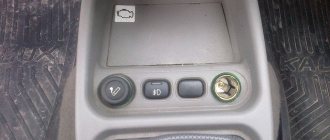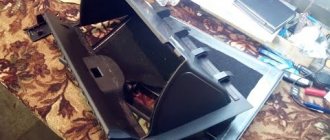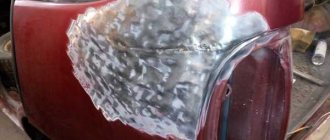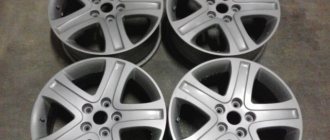In relation to a car, a jerk is a short-term spontaneous change in the speed of the engine crankshaft, regardless of the position of the accelerator pedal.
In everyday use, as a rule, there are a series of jerks. The extreme case of a jerk is a failure - a noticeable delay in the engine's response to pressing the accelerator pedal.
Conventionally, three types of jerks can be distinguished:
- at the moment of starting movement;
– with steady motion, i.e. with the accelerator pedal in constant position.
To determine the causes of jerks when driving a car with an injection engine, special diagnostic equipment is required, so in this case we recommend contacting a service that specializes in repairing fuel injection systems.
As practice shows, in most cases jerking is caused by insufficient fuel pressure in the fuel rail, malfunction of the throttle position sensor or mass air flow sensor.
If you have some skills, you can determine the cause of jerking yourself.
Wheels from the factory are not the same as in the instruction manual (Lada XRAY)
For the Lada X Ray, the instruction manual (at the very end) states the wheel sizes R16 PCD: 4×100 DIA: 60.1, 6.0×16 ET41, but in reality the car has R16 wheels with an offset of ET50.
The technical staff at the officials (Boravto on Ostuzhev in Voronezh) did not say anything intelligible. Lada (“Lada”) is a brand of cars produced by AvtoVAZ JSC. Previously, it was used only for export cars, and for the domestic market, cars were produced under the Zhiguli brand. In 2022, the management of AvtoVAZ announced the transition to the Latin alphabet for the official spelling of the names of all cars produced by the plant: Lada - instead of "VAZ" and "Lada".
When shifting gears from 1st to 2nd there is a push of the prior
Fluid used: ATF Dexron VI from any manufacturer. Mixing is allowed. The use of tolerances below is PROHIBITED. A typical example of deception is Liqui Moly Top Tec 1200, which meets the Dexron III specification, but the manufacturer claims that it can be used in units designed for Dexron VI. The oil specification does not comply with the temperature limits for maintaining properties, viscosity and sulfonate additive package, which are extremely important for automatic transmissions of the 6TXX type. That is, the car will run on any hydraulic oil, and will even run for some time, only the behavior under load, as well as when cold, will be different, and the service life will certainly decrease by an indefinite amount.
This is interesting: Registration of a lease agreement for non-residential premises in the Rosreestr 2022
One of the above is filled into original GM cans, so relying on the original packaging as if it were sacred makes no sense. By purchasing one of the above brands, you can get exactly the same liquid, so you can proceed from the principle of what is available and what is cheaper. ——————————————————— Automatic transmission filling volume: full (achievable only during major repairs) — 7.6 l partial (by draining through the drain plug of the pan) — 4.5 — 5.5 l ——————————————————— Technology for checking the oil level in an automatic transmission (there is no dipstick and never has been): On a warm car with a filled clutch and valve block (a small amount is required trip, or alternate movement of the gear selector 2-3 times throughout the entire range with a delay of 5-10 seconds in each position) unscrew the control plug WITH THE ENGINE RUNNING (key 11)
Car jerking - malfunction in the carburetor chamber and pump
If the engine starts to run jerkily in carburetor cars even when the gas pedal is lightly pressed, the main attention should be focused on the carburetor chamber. The problem is often associated with clogged outlets, which are located in the first of the carburetor chambers.
When the fuel enters the engine, it takes with it some of the soot and metal shavings, as a result of which the mixture undergoes changes and the engine operates unstably. You can solve this problem yourself - just remove the carburetor and blow out all its pipes and holes with compressed air.
A classic example is the following situation: when replacing the front wheel bearing on a VAZ-2109, the pump was damaged. As a result of the failure of the carburetor accelerator pump, the mixture is supplied to the engine in an incomplete volume. The result is the appearance of jerks during even a smooth attempt to move away. In most cases, it seems impractical to repair pumps, which is why they are simply replaced at a car service center.
carburetor chamber
If the Lada Priora's starter does not turn
Possible malfunction
Burnt starter commutator, stuck brushes or severe wear
Open or short circuit in the starter armature winding
| Diagnostics | Remedies | |
| Low battery | The voltage at the battery terminals without load is less than 12V. When trying to start the engine, a cracking noise is heard from under the hood. | Charge the battery or replace it with a new one |
| Oxidation of battery terminals or wire terminals, their fit is not tight | When you try to start the car, the voltage in the on-board network drops much more than at the battery terminals. In this case, a crash may be heard under the hood. | Clean the contacts, lubricate them with petroleum jelly and tighten the terminals |
| The engine or attachments are jammed | Check the rotation of the crankshaft, pump and generator pulley. | Repair engine, generator, pump |
| The starter is faulty, the starter drive gear or flywheel ring teeth are damaged | Remove and inspect the starter. | Repair or replace starter |
| The starter switching circuit or starter relay is faulty, the wires are damaged, or the ignition switch contacts do not close | When the key is turned to position “II”, the starter traction relay does not operate (a click is not heard under the hood). Check the +12V supply to the control contact of the traction relay. | Replace starter relay, wires, ignition switch |
| The starter traction relay is faulty, there is a short circuit or break in the retractor winding, the relay armature is stuck | When the key is turned to position “II”, the traction relay does not operate (there is no click under the hood), but + 12V is supplied to the control contact of the traction relay. Remove the relay and check its operation. | Replace the traction relay |
| Contacts or wires of the traction relay are oxidized, poor ground contact | When the starter is turned on, a clicking sound is heard under the hood, but the starter armature does not rotate. Using an ohmmeter, check the resistance of the battery-starter circuit, as well as the ground wire. If the circuit is in good condition, remove the starter and check the operation of the traction relay by applying +12V to it from the battery | Tighten the terminals, clean the contacts, replace the traction relay |
| Open or short circuit in the holding winding of the traction relay | When you try to start the engine, you hear a crashing sound under the hood. The battery voltage is within normal limits. We check the traction relay with an ohmmeter or by its excessive heating. | Replace the traction relay |
| The starter armature rotates slowly or does not rotate at all. Check the traction relay by applying voltage to the starter contact bolt directly from the battery | Replace starter or armature | |
| Freewheel slipping | When the starter is turned on, the armature rotates, the flywheel is stationary | Replace clutch or starter |
Reason 5 – mass air flow sensor or ECU firmware
A malfunction of the mass air flow sensor on a Priora leads to the control unit receiving incorrect data on the amount of incoming air, as a result of which the air-fuel mixture is not prepared correctly, and the car may begin to twitch. The malfunction is determined using diagnostics at a service center.
The price of the sensor is not at all budgetary for a Priora - about 4,000 rubles. You can change it yourself. To do this, first disconnect the negative battery terminal, then the wire connector and unscrew the pipe clamp. After this, use a wrench to unscrew the two screws securing the air filter housing and carefully remove the sensor.
Inappropriate ECU firmware leads to the same symptoms. The air-fuel mixture is not prepared correctly, and interruptions may occur during engine operation. This can be caused by improper chip tuning or a malfunction of the “brains” themselves. In any case, only competent diagnosis will help here. It usually costs about 500 rubles. After diagnosis, the technician will tell you exactly how to solve the problem.
Also read: We are looking for a reliable friend: what pitfalls of the Opel Corsa D should you know before buying
Inspection of high voltage wire
Often, the Priora stalls when accelerating due to a malfunction of the ignition system. This is especially true for the condition of the high-voltage wire leading to the spark plug. To inspect it, you will need to remove the tip attached to the spark plug. The structure of a high-voltage wire is as follows: the winding contains the central core of the wire. The tip, which is put on the candle, has a persistent metal penny. The main purpose of this element is to transmit current to the spark plug.
The core of the high-voltage wire should fit as closely as possible to the “penny” of the steel tip placed on the spark plug. Due to aging, contact between this element and the wire may be lost due to oxidation of the metal. As a result, tripling occurs. The oxidation of the contact is checked as follows: with the second probe of the multimeter, you should touch the central core of the high-voltage wire; if the core of the high-voltage wire burns out along its entire length, then it is possible to identify such a section using a special multimeter tip.
The wire is pierced until the affected area is identified every 5-10 mm. If such a section is detected, it is cut off if the length of the high-voltage wire allows it. Otherwise, it needs to be replaced.
Jerks when moving
The moment the car starts moving, most often there is a failure. Unpleasant sensations are associated with a delay in the engine's response to pressing the accelerator pedal. In some cases, the engine stalls. A jerk occurs when the throttle valve opens, when, based on a signal from its position sensor, the ECU determines the moment of transition from cold mode to load mode. This is aimed at increasing the amount of fuel supplied through the injectors. Due to insufficient pressure in the fuel line, there is not enough fuel to move the Lada Priora smoothly.
For this reason, the car stalls when accelerating. In this case, the electronic control unit of the engine, having received a message from the throttle position sensor about the intensive opening of the damper at a large angle, strives to increase the fuel supply as much as possible. This is impossible to do due to low fuel pressure.
During steady motion, jerking is caused by a malfunction of the ignition system. In this situation, the vehicle will need to be diagnosed and repaired. If this problem occurs on the road, then auto mechanics advise Lada Priora owners to follow these steps:
Maximum acceleration of Lada
- inspect the space under the hood - turn off the ignition, and then check that the wiring harness blocks are securely attached to the ignition coils. You need to start the engine, listening to its operation: the crackling sound during a high voltage breakdown is weak, but clear. In complete darkness, a spark should be visible upon breakdown,
- Replace spark plugs regardless of mileage and condition. You need to pay attention to the condition of the spark plugs: if it is abnormal, then you will need to repair the engine or its elements. Causes jerking during steady movement of Lada with an injector, a possibly faulty throttle position sensor. Additional reasons confirming the malfunction of this unit are: uneven operation of the engine at idle, reduction in maximum engine power.
Reason 1 – spark plugs
Spark plugs are the first thing to check when the Priora jerks while driving. If they were rarely changed and the car was filled with low-quality fuel, carbon deposits could appear on the electrodes. This leads to misfires, as a result of which the car begins to twitch while driving.
The cost of candles for Priora varies greatly depending on the manufacturer. The simplest ones cost 250 rubles for four pieces.
You can change it yourself if you have a spark plug wrench, or contact service. The service costs from 400 rubles depending on the technical center.
Also read: Don’t be shy: who should buy a used Daewoo Matiz
Reason 2 - ignition coils
The signs of this malfunction are the same as for spark plugs - misfire. As a result, the Priora jerks at speed, and the revs drop when you press the gas sharply. The reason may be candles - they are either of low quality or incorrectly selected.
The malfunction can be determined by pulling out the ignition coils one by one. If you disconnect a working coil, the tripping will increase, but if you disconnect a faulty coil, there will be no change.
The issue price is from 850 rubles for an analogue.
Also read: Five with a minus: what is wrong with Skoda Octavia A5 engines
Checking the technical condition of the AMT box in case of problems
- Clutch wear may also be indicated by the appearance of a burning smell , emitted by the highly heated friction linings of the driven disc. In this case, it is necessary to replace the clutch.
Recommendations: If it is not possible to restore the functionality of the gear shift mechanism or the electric clutch release drive (for example, due to a lack of spare parts), then the AMT can be converted to manual control . To do this, it is necessary to dismantle the specified parts and install a gear shift mechanism with a cable drive, as well as a clutch release cable.
Why does the engine stall when it is hot, and a well-warmed engine does not start?
1. The first possible reason is the carburetor. During movement, a large amount of air passes through it, due to which the carburetor is seriously cooled, at the same time the fuel that passes through it is also cooled. As a result, the carburetor temperature is several times lower than the engine temperature. Because of this feature, problems arise; after a long journey, you turn off the engine and make a short stop, at which time the carburetor begins to get very hot from the hot engine body. The remaining gasoline in the float chamber begins to evaporate from the high temperature, filling the voids - the air filter, the intake manifold and the carburetor itself. Air pockets form, and not a drop of fuel remains in the float chamber.
The solution to the problem is quite simple - press the gas pedal halfway several times and try to start the engine. This will make the mixture leaner and release excess evaporation. It should be noted that problems with hot starting can also be due to a similar problem, only due to the fault of the fuel pump or fuel line. This usually happens in hot weather when air pockets form from evaporation in the fuel system or pump, preventing fuel from entering the carburetor.
2. The second possible reason for the strange behavior of a warm engine is problems with the starter. Make sure that when you try to start the engine, the starter turns and does not just click or not respond at all. If this is the case and one of the above options is confirmed. the starter needs to be checked. If you are on the road, then the check can be reduced to a basic check of the starter power wire or other visual operations. If you get home, perform a detailed check of the starter according to these instructions. In case of malfunction, repair or replace it.
3. Alternatively, the reason when the engine does not start when hot may be a dead battery due to the reason described above, when the generator did not charge and the battery was completely dead.
Well, it seems like you didn’t miss anything!? That's all for today, we hope the article will help, tell you the cause of the breakdown and help you solve your problem. If you know other reasons, as well as ways to solve them, you can supplement the article using the comment form. Thank you for your attention.
Preventing gearbox breakdowns
Have you heard, while standing in a traffic jam, how a car in the next row starts to make a characteristic loud crunch? Know that this is not a normal situation, but a consequence of improper handling of the clutch.
There are three rules, the observance of which will prolong the life of the gearbox:
- You should learn to shift gears smoothly.
- If possible, do not use the “swing” exit from a hole or mud.
- It is necessary to put the car in neutral when standing at a long traffic light.
Learn more about this and other rules for driving a car with automatic transmission in the video:
This is interesting: an adaptive automatic transmission can copy the wrong driving style and, thus, again and again reproduce the driver's habits that are painful for the gearbox.
Idle speed sensor
If the car jerks while driving, first you need to check the idle speed sensor. A malfunction of the idle speed sensor is very difficult to identify, since most often it does not cause a Check Engine error, which signals the presence of problems and shows which unit is not working.
There are three main faults
- Sensor contamination. The sensor is contaminated with oils, dust, oils, crankcase gases
- Mechanical damage associated with the rod, threaded connection, rivets flying out, etc.
- Failure of the electrical part. These malfunctions include winding combustion or a short circuit inside the sensor.
Reason 4 – fuel filter
This is perhaps one of the most common reasons why the Lada Priora twitches.
Like any other filter, the fuel filter becomes clogged over time. The reason is low-quality fuel and dusty air, so it is better to refuel at proven gas stations.
You can check a clogged filter yourself using a conventional pressure gauge, tube and clamp. For this:
- Unscrew the cap from the fuel rail fitting.
- Using the tire nipple cap, unscrew the spool and connect the pressure gauge, securing the tube with a clamp.
- Start the car and check the pressure reading. If it is less than normal - 3.8-4 kgf/cm2, the cause of the twitching most likely lies in the filter.
At a service center, a pressure check service will cost about 300 rubles.
You can replace the fuel filter at home. The part costs about 300 rubles. If there is no desire or opportunity, contact the service center. There they will charge from 500 rubles for the service.
Also read: Risks of purchasing and maintaining Volkswagen Polo V











